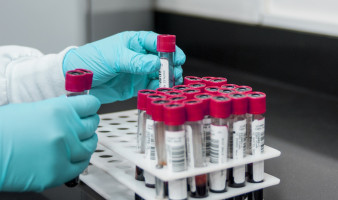
Many patients see their tumours shrink in response to a drug, only to have them come back with a vengeance as they evolve to fend off the treatment.
Oncologists want to be able to quickly detect cancer drug resistance as it emerges in their patients and identify another drug the tumours will still respond to.
A new study from a group of researchers at the Broad Institute of MIT and Harvard, Massachusetts General Hospital (MGH), IBM Research, and other organisations is one step forward in that direction.
The researchers examined a new method for sampling tumours known as liquid biopsy - a blood sample from a patient that contains DNA shed from tumours, called circulating tumour DNA, or ctDNA, which can be isolated and analysed.
The research team compared the results of both liquid and standard tissue biopsies from patients who were treated for gastrointestinal cancer but developed drug resistance.
The findings, published today in Nature Medicine, reveal that liquid biopsies provide a more complete picture of both the genetic diversity of a patient's cancer and how tumours evolve drug resistance at the molecular level.
That picture is challenging the view of how cancer drug resistance typically emerges, with important implications for treatment.
"Remarkably, we found that nearly every patient we analysed had developed not just one, but multiple drug resistance mechanisms simultaneously, and this may be more common than we previously thought," said Gad Getz, co-senior author of the study, director of the Cancer Genome Computational Analysis Group at the Broad and the Paul C. Zamecnik Chair in Oncology at the MGH Cancer Center. "That is a real paradigm shift and will force us to rethink not just the biology of cancer drug resistance but also how we approach it therapeutically in the future."
The results could explain why cancer, once it has developed drug resistance, is so difficult to defeat. The study also suggests possible molecular mechanisms underlying drug resistance, which could point the way to new and more personalised therapeutics.
Tissue biopsies are a mainstay of cancer diagnosis, but they are invasive and provide a glimpse of only one location in a single tumour.
Yet tumour cells, even nearby ones, can be genetically distinct from one another.
Liquid biopsies, which incorporate information from multiple tumour lesions, are a promising alternative, but are rarely used in the clinic.
To investigate the utility of liquid biopsies in detecting acquired drug resistance in cancer, Getz, co-senior author Ryan Corcoran, an investigator at MGH and Harvard Medical School, and their colleagues, including first authors Aparna Parikh, Ignaty Leshchiner, and Liudmila Elagina, studied 42 patients with different forms of gastrointestinal cancer who were undergoing treatment with targeted drugs.
When the patients showed signs of drug resistance, the researchers analysed their tumours using both liquid and tissue biopsies.
They harnessed a suite of computational tools developed at the Broad Institute, known as PhylogicNDT, to analyse the tumour DNA and their resistance mutations.
A head-to-head comparison of liquid and tissue biopsies revealed that in nearly 80% of cases, the liquid biopsies unearthed clinically relevant genetic alterations linked to drug resistance that were not identified through standard tissue biopsies.
"This study is the largest to date to directly compare liquid biopsy to tumour biopsy in the setting of cancer resistance," said Corcoran. "Our findings suggest that liquid biopsy may be the preferred clinical modality for assessing how patients' tumours have evolved after they've become resistant to therapy."
Analysis of DNA from several of the patients in the study didn't show clear resistance mechanisms.
To learn more about these cases, the IBM researchers on the team developed machine learning algorithms to group patients together according to shared or similar patterns of genetic alterations linked to drug resistance.
By doing this, the researchers were able to suggest possible resistance mechanisms for these cases.
The study is part of a five-year collaboration between the Broad Institute and IBM Research to analyse tumours before and after the onset of drug resistance, in order to discover underlying mechanisms driving resistance.
The collaboration grew out of a cancer drug resistance and blood biopsy project supported by the Gerstner Family Foundation.
"The IBM, Broad and MGH teams bring complementary expertise and tools to the table while grappling with the difficult problem of extracting meaning from the data, and this interaction has proved to be very fruitful," said Laxmi Parida, IBM Research Fellow, Computational Genomics, and co-PI, along with Getz, on the Broad/IBM collaboration. "The collaboration has been particularly exciting not only due to the exceptional synergy between the teams but also the invaluable data that are being collected for use by the entire research community."
Although this new study turned up some tantalising findings, the authors emphasise that larger, more comprehensive efforts are needed to fully understand cancer drug resistance.
"To really map out the full landscape of cancer resistance mechanisms, we need much larger studies that span a variety of drugs and cancer types," said Getz.
We are an independent charity and are not backed by a large company or society. We raise every penny ourselves to improve the standards of cancer care through education. You can help us continue our work to address inequalities in cancer care by making a donation.
Any donation, however small, contributes directly towards the costs of creating and sharing free oncology education.
Together we can get better outcomes for patients by tackling global inequalities in access to the results of cancer research.
Thank you for your support.